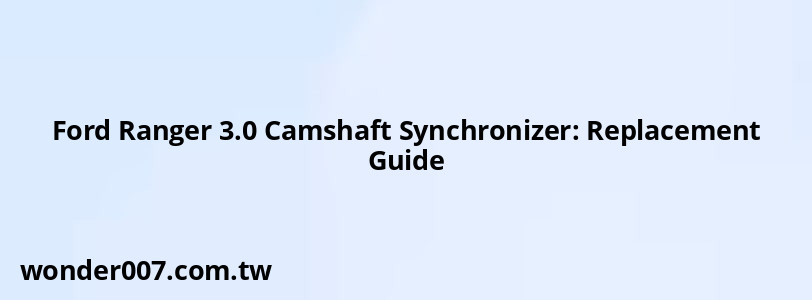Ford Ranger 3.0 Camshaft Synchronizer: Replacement Guide

The camshaft synchronizer is a crucial component in the Ford Ranger 3.0L engine, responsible for ensuring proper timing between the camshaft and crankshaft. This guide provides essential information on identifying, replacing, and maintaining the camshaft synchronizer to prevent engine damage.
Understanding the Camshaft Synchronizer
The camshaft synchronizer works with the camshaft position sensor to determine the precise position of the camshaft. It is located at the back of the engine, near the firewall, and is vital for maintaining engine timing. A failing synchronizer can lead to serious issues, including engine misfires, poor performance, and even complete engine failure.
Symptoms of a Failing Camshaft Synchronizer
- Squeaking or Chirping Noises: A common sign of wear.
- Check Engine Light: Often triggered by a malfunctioning sensor.
- Rough Idling: The engine may idle inconsistently.
- Poor Fuel Efficiency: Increased consumption due to timing issues.
Replacement Process
Replacing the camshaft synchronizer is a manageable task for those with basic mechanical skills. Here’s a step-by-step guide:
Tools Needed
- 10mm socket
- 5.5mm or 7/32 socket
- Ratchet and extension
- White paint marker or black Sharpie
- Engine oil (for lubrication)
- Clean rags
Steps to Replace
1. Preparation:
- Disconnect the battery to prevent electrical shorts.
- Ensure you have ample lighting and space to work.
2. Locate the Synchronizer:
- The synchronizer is situated at the back of the engine, near the passenger side firewall.
3. Mark Position:
- Before removal, use a marker to note the position of the old synchronizer. This is critical for proper installation.
4. Remove Old Synchronizer:
- Use the 10mm socket to remove the retaining bolt.
- Disconnect any electrical connectors attached to the synchronizer.
5. Install New Synchronizer:
- Align the new synchronizer according to your markings.
- Insert it into place and secure it with the retaining bolt.
- Reconnect any electrical connectors.
6. Final Checks:
- Reconnect the battery and start the engine.
- Listen for any unusual noises and check for warning lights on the dashboard.
Important Considerations
- Alignment is Critical: If not installed correctly, you may experience misfires or other performance issues.
- Regular Maintenance: It's advisable to check and lubricate your camshaft synchronizer periodically, especially if your vehicle has high mileage (over 100,000 miles).
- Quality Parts Matter: Always use OEM or high-quality aftermarket parts to ensure reliability.
FAQs About Ford Ranger 3.0 Camshaft Synchronizer
- What happens if I don't replace a failing camshaft synchronizer?
Failure to replace it can lead to severe engine damage due to improper timing. - How often should I replace my camshaft synchronizer?
It's recommended to replace it every 100,000 miles or if you notice symptoms of failure. - Can I replace it myself?
Yes, with basic tools and mechanical knowledge, it can be done at home.
Related Posts
-
2017 GMC Sierra: Low Pressure Port Location and Guide
28-01-2025 • 191 views -
AC System Won't Hold Vacuum but Will Hold Pressure: Troubleshooting Guide
29-01-2025 • 200 views -
89 Jeep Wrangler Turn Signal Lever: A Comprehensive Guide
28-01-2025 • 211 views -
2017 Chevy Malibu Windshield Washer Pump Replacement
31-01-2025 • 169 views -
Electric Power Steering Warning Light: Troubleshooting Guide
30-01-2025 • 164 views
Latest Posts
-
Are O2 Sensors Covered Under Warranty
01-02-2025 • 378 views -
2015 Chevy Traverse AC Recharge Port Location
01-02-2025 • 418 views -
Power Steering Fluid Leak On Passenger Side
01-02-2025 • 461 views -
Rear Brake Caliper Piston Won't Compress
01-02-2025 • 361 views -
How To Turn Off Paddle Shifters Mercedes
01-02-2025 • 387 views
Popular Posts
-
Hino Warning Lights: Understanding Dashboard Alerts
26-01-2025 • 795 views -
EPC Light: Understanding Causes and Solutions
26-01-2025 • 1065 views -
Toyota Hiace: Fuel Efficiency Insights for 2025
26-01-2025 • 646 views -
Power Steering and ABS Light On: Causes and Solutions
27-01-2025 • 650 views -
V12 Engine Costs: What You Need to Know
26-01-2025 • 688 views
